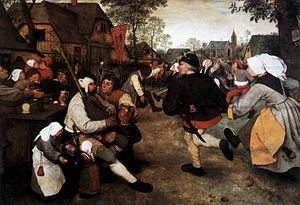Year 1567 | Created 1567 | |
 | ||
Dimensions 114 cm × 164 cm (45 in × 65 in) Similar Pieter Bruegel the Elder artwork, Other artwork | ||
The Peasant Dance is an oil-on-panel by Flemish renaissance artist Pieter Bruegel the Elder, painted in c. 1569. It is currently held and exhibited at the Kunsthistorisches Museum in Vienna.
Contents
Description
This panel, not signed nor dated, was looted by Napoleon Bonaparte and brought to Paris in 1808, being returned in 1815. It was painted at about the same time as The Peasant Wedding, that is, circa 1567. The sizes of the two paintings are the same and they may have been intended as a pair or as part of a series illustrating peasant life. They are the two most outstanding examples of Bruegel's late style, which is characterized by his use of monumental Italianate figures.
Details
Like The Peasant Wedding, it is likely that Bruegel intended this painting to have a moral sense rather than simply being an affectionate portrayal of peasant life. Gluttony, lust and anger can all be identified in the picture. The man seated next to the bagpipe player wears a peacock feather in his hat, a symbol of vanity and pride. The occasion for the peasants' revelry is a saint's day, but dancers turn their backs on the church and pay no attention whatsoever to the image of the Virgin which hangs on the tree. The prominence of the tavern makes it clear that they are preoccupied with material rather than spiritual matters.
